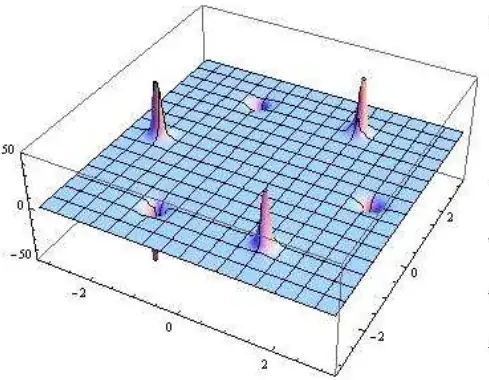It is well-known that in TI-symmetric semi-metals the Berry curvature on the Brillouin torus vanishes away from the nodal points (eg. [XCN10, III.B] [Van18, p. 105]).
But even for non-TI-symmetric semi-metals, the Berry curvature turns out, in concrete examples, to be strongly concentrated (spiked, see the figures below) around the nodal points, meaning that it tends to effectively vanish away from the nodal points (eg. [Yao+92, Fig. 3] [WYSV06, Figs. 3,6] [FPGM10, Fig. 1] [YXL14, Fig. 1] [Van18, p. 206]).
The following cartoon picture of the situation may help convey why this seems to be remarkable:
Is this concentration of Berry curvature around nodal points understood on general grounds?
In [SF15, p. 3] (more recently repeated in [ZNT21, p. 1]) it says, broadly and without any reference:
Berry curvature often concentrates in small regions in momentum space where two or more bands cross or nearly cross.
What's the status of this statement? What is "often"? Is there a more authorative or at least more comprehensive reference for this general phenomenon?
$\;$
References:
- [FPGM10] J. N. Fuchs, F. Piéchon, M. O. Goerbig, G. Montambaux: "Topological Berry phase and semiclassical quantization of cyclotron orbits for two dimensional electrons in coupled band models", Eur. Phys. J. B 77 (2010) 351–362 (arXiv:1006.5632, doi:10.1140/epjb/e2010-00259-2)
[SF15] I. Sodemann, Liang Fu: "Quantum Nonlinear Hall Effect Induced by Berry Curvature Dipole in Time-Reversal Invariant Materials", Phys. Rev. Lett. 115 (2015) 216806 (doi:10.1103/PhysRevLett.115.216806)
[Van18] D. Vanderbilt: "Berry Phases in Electronic Structure Theory" (2018) (doi:10.1017/9781316662205)
[XCN10] D. Xiao, M.-C.Chang, Q.Niu: "Berry Phase Effects on Electronic Properties", Rev. Mod. Phys. 82 (2010) 1959-2007 (arXiv:0907.2021, doi:10.1103/RevModPhys.82.1959)
- [WYSV06] X. Wang, J. R. Yates, I. Souza, D. Vanderbilt: "Ab initio calculation of the anomalous Hall conductivity by Wannier interpolation", Phys. Rev. B 74 (2006) 195118 (arXiv:cond-mat/0608257, doi:10.1103/PhysRevB.74.195118)
[Yao+92] Y. Yao, L. Kleinman, A. H. MacDonald, J. Sinova, T. Jungwirth, D.-s. Wang, E. Wang, Q. Niu: "First Principles Calculation of Anomalous Hall Conductivity in Ferromagnetic bcc Fe", Phys. Rev. Lett. 92 (2004) 037204 (doi:10.1103/PhysRevLett.92.037204)
[YXL14] F. Yang, X. Xu, R.-B. Liu: "Giant Faraday rotation induced by Berry phase in bilayer graphene under strong terahertz fields}, New J. Phys. 16 (2014) 043014 (arXi:1307.7987, doi:10.1088/1367-2630/16/4/043014)
- [ZNT21] C. Zeng, S. Nandy, S. Tewari: "Nonlinear transport in Weyl semimetals induced by Berry curvature dipole}, Phys. Rev. B 103 (2021) 245119 (doi:10.1103/PhysRevB.103.245119)




